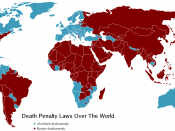The Effects of Race on Sentencing in Capital Punishment Cases
Throughout history, minorities have been ill-represented in the criminal justice system, particularly in cases where the possible outcome is death. In early America, blacks were lynched for the slightest violation of informal laws and many of these killings occured without any type of due process. As the judicial system has matured, minorities have found better representation but it is not completely unbiased. In the past twenty years strict controls have been implemented but the system still has symptoms of racial bias. This racial bias was first recognized by the Supreme Court in Fruman v. Georgia, 408 U.S. 238 (1972). The Supreme Court Justices decide that the death penalty was being handed out unfairly and according to Gest (1996) the Supreme Court felt the death penalty was being imposed 'freakishly' and 'wantonly' and 'most often on blacks.' Several years later in Gregg v.
Georgia, 428 U.S. 153 (1976), the Supreme Court decided, with efficient controls, the death penalty could be used constitutionally. Yet, even with these various controls, the system does not effectively eliminate racial bias.
According to Professor Steven Goldstein of Florida State University, 'There are so many discretionary stages: whether the prosecutor decides to seek the death penalty, whether the jury recommends it, whether the judge gives it' (As cited in Smolowe, 1991, 68). It is in these discretionary stages that racial biases can infect the system of dealing out death sentences. Smolowe (1991) shows this infection by giving examples of two cases decided in February of 1991, both in Columbus. The first example is a white defendant named James Robert Caldwell who was convicted of stabbing his 10 year old son repeatedly and raping and killing his 12 year old daughter. The second example is of a black...


